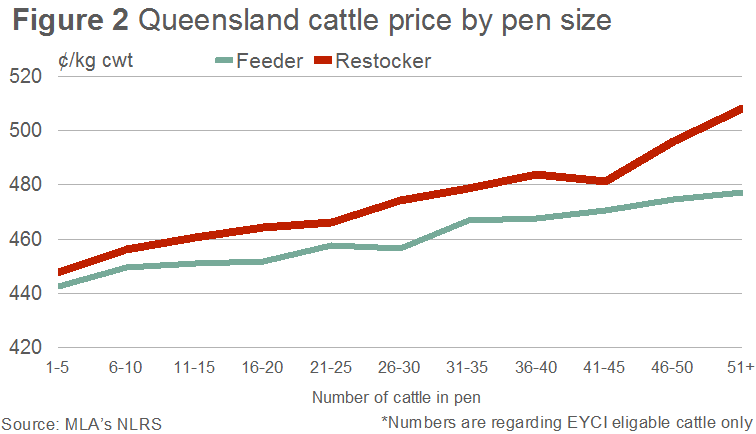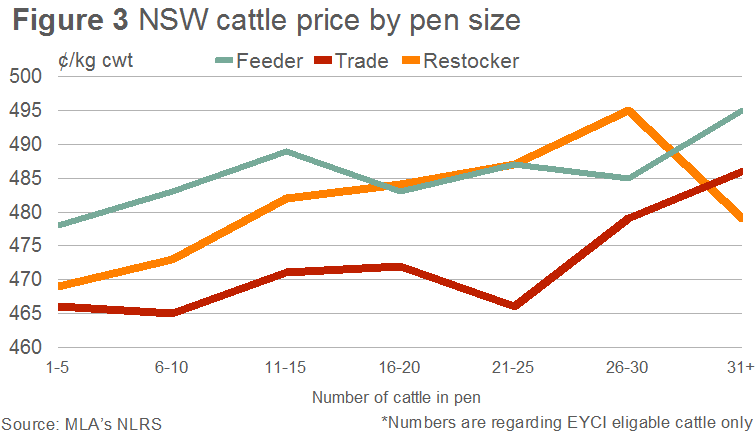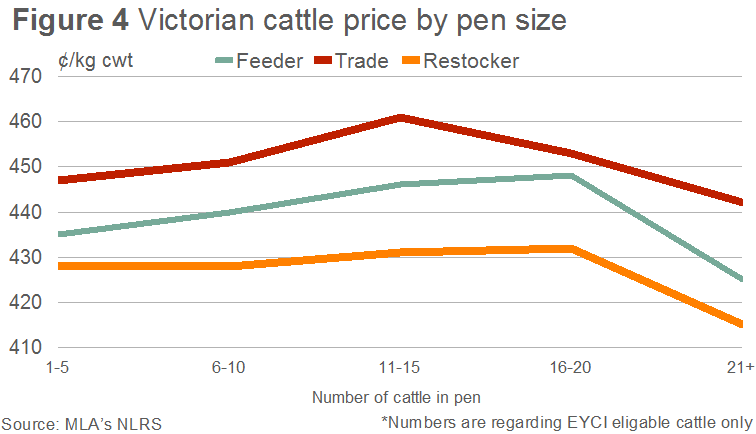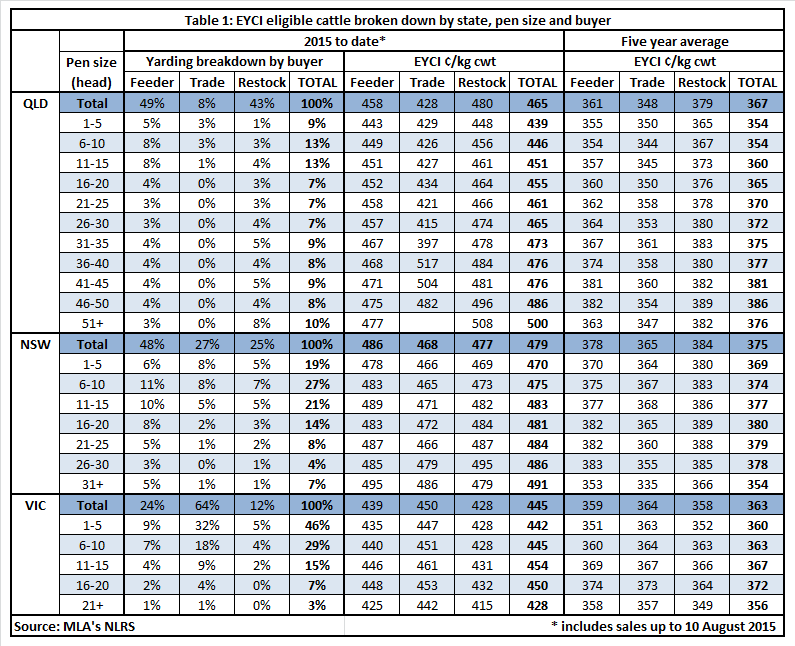Selling cattle? Pen size matters
When selling cattle through saleyards, does the size of the pen really impact price? This is a question often asked and the short answer is yes, but one needs to look at the details to see how it might impact individual selling and buying decisions.
The full price breakdown (by buyer, state and pen size) is detailed in the table at the end of this article.
Figure 1 illustrates the breakdown by pen size of Eastern Young Cattle Indicator (EYCI) eligible cattle through NLRS reported Queensland, NSW and Victorian saleyards in 2015. Between the states there is a wide variation in typical pen size. In particular, Victorian cattle are most commonly sold in lots between 1 and 5 head – a stark contrast to lines in Queensland, where a much higher proportion are sold in lots greater than 20 head.

Clearly there’s a wide variation in selling methods between the states but what pen size is optimal?
Queensland
In total, over half of EYCI eligible cattle through Queensland saleyards are sold in pens over 20 head. On average, cattle in pens greater than 20 head have made an additional 29¢/kg carcase weight (cwt) compared to smaller pen lots. In fact, as illustrated in Figure 2, the larger the pen size, the higher the average price received (few Queensland slaughter cattle were recorded in the EYCI, so have they not been represented in Figure 2).

This data is skewed towards the major markets of Roma Store and Dalby, which arguably host the largest pen sizes in the country, but vendors should note that there are still premiums on offer for larger pens in smaller saleyards in south-east Queensland. With the large feedlot buyer presence at Queensland markets, there is a strong relationship between pen size and price, as feeder buyers generally look to buy cattle of uniform specifications for ease of feedlot entry and pen management. Another factor for the premium may be the simpler and more cost effective logistics of purchasing larger pens.
NSW
The relationship is less clear in NSW, but it is still a positive one. As illustrated in Figure 3, cattle in pens with 11-15 head sell 5¢ to 15¢/kg cwt dearer than those in pens of 1-5 head. There is relatively little difference in price amongst cattle in pens between 11 and 25 head, however there is a general lift in price once the pen exceeds 25 head. Purchases by restockers are the exception in the largest pen category (31+ head), however most of these cattle are purchased by feeder buyers.

Given about half of cattle sold through NSW saleyards are in pens of 10 head or less, there are possible gains to be made by shifting pen sizes up. This is particularly true for secondary cattle, more suited to restocker and feeder buyers.
Victoria
A much higher proportion of slaughter cattle go through Victorian saleyards (64% of EYCI eligible cattle). Again, there are premiums for cattle in larger sized pens, however in Victoria this is only up to a certain point. As illustrated in Figure 4, on average, cattle in pens of 11-15 head sold to the dearest price, about 10¢/kg cwt above those in the smaller lots.

While the average price for cattle in pens greater than 15 head is relatively lower, this portion of the market only represents 10% of total throughput. The greatest variation in price relative to pen size is for cattle destined for slaughter, as trade buyers seek larger pens of consistent size and quality cattle to simplify processing and provide a more uniform product.
The smallest variation in price is for cattle returning to the paddock. Restockers are likely to be less concerned about purchasing larger parcels of uniform cattle, as stock will most often just go out onto pasture to be grown out. Limited cash flow may also hinder the purchase of larger lines of cattle.
So what does this mean? While many factors influence price, it is clear that pen size is one of them.
- The relationship between pen size and price is most clearly defined for cattle in Queensland, but 42% of cattle are still sold in pens of 1-20 head.
- Furthermore, the spread between the largest pen category in Queensland and the smallest is 60¢/kg cwt. On a 400kg lwt animal (roughly 210kg cwt) this difference equates to about $125/head.
- The premiums are not as large in the south, but, given that 46% of cattle in Victoria are sold in pens of 1-5 head and the optimal pen size is 11-15 head, a shift to larger pens may be still be beneficial for vendors.
- A similar account may be made for NSW, where 47% of cattle are sold in pens of 1-10 head, but a clear premium exists for larger lots. Given the greatest price jump in NSW is recorded when the 10 head per pen mark is exceeded, even increasing pen size by a relatively minor amount may provide valuable returns.
However, there are many constraints in being able to deliver certain size pen lots, such as farm management practices, herd size, logistics and saleyard capacity. Furthermore, there are many other and important factors, such as quality, which also impact the returns on offer and which should be considered when making selling decisions.
The full breakdown of cattle by category and state is available, below, in Table 1.




